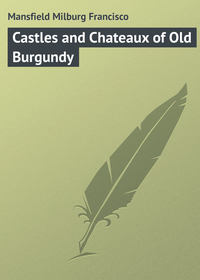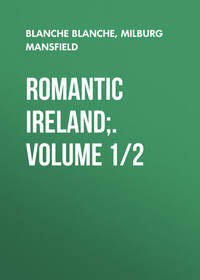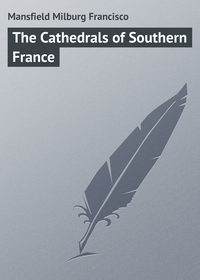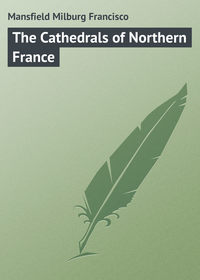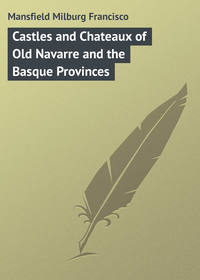 полная версия
полная версияRomantic Ireland. Volume 2/2
Leaving the coast and going inland, as there is every facility for doing, one finds the finest lakes in the United Kingdom; and, if there are no Mont Blancs or Matterhorns, there are, at least, beautiful hills and mountains with no less charm and none of their difficulty of access. The great Atlantic waves beat against the wild rocks of the south Irish coast; but the Gulf Stream gives warmth of an almost subtropical mildness to the fresh sea air, and the lowlands are enriched by the soft rains which wash the hills and fall into the great arms of the sea, called Bantry Bay, Kenmare River, and Dingle Bay.
Farther north is the ample estuary of the river Shannon and Galway Bay, each with much the same characteristics. To take a steamer from Cork for a tour of the southwest coast will form a unique experience in the itinerary of most folk. Rounding Cape Clear, the small coasting-steamer makes the first stop at the little village of Schull, which stands at the farther extremity of an almost landlocked bay. Here the land on three sides gently shelves to low ranges of verdant hills, while the harbour is speckled with its fishing craft.
Leaving Schull, a half-hour or more is passed before we are clear of the many rocky islands of its harbour and come to a view of Brow Head, with its signal-station. Mizen Head and Sheep’s Head are seen in their turn; and the dawn finds the ship snugly anchored at Berehaven. Here at Castletown-Berehaven we are at the home station of the Channel fleet during the autumn manœuvres. Before us is the grand panorama of Glengarriff and the mountains which shelter Killarney’s lakes; while seaward is only the vast surge of the Atlantic.
The splendid bay of Bantry, which takes its name from the town which lies sheltered at its head, is unsurpassed as a harbour and roadstead throughout the world. Here the sturdy Atlantic swell, blue as sapphires, rolls in great lashes of foam; and Berehaven, just inside the Bear or Bere Island, is the base of the yearly autumn manœuvres of the English Channel fleet. From any view-point this rugged, walled bay is more than impressive, – more impressive, even, than Glengarriff itself, which lies still farther inland, its circumference dotted with weed-embroidered boulders. Bantry Bay is twenty-one miles in length; from three to five in width; and has a depth, in parts, as great as 220 feet. Berehaven and Castletown, which are nearest the open sea, lie just inside a jagged fang, which, once rounded, opens up an obscure aperture in the coast-line, and discloses a harbour in which, truly, all the fleets of the world might lie at anchor.
Twice the French fleet invaded Bantry Bay. The first time, in 1689, in aid of James II.; and the second, in 1796, by the ill-favoured expedition organized by General Hoche, when the Surveillante was engulfed, and the foe-laden fleet ultimately took their departure without disgorging their army. This latter fleet, which had been arrayed for the invasion of Ireland by Carnot and Clarke, with Theobald Wolfe Tone as the organizer of the Irish Republicans, consisted of twenty-six sail, with a force of nearly seven thousand men. The O’Sullivans were the ancient chieftains or princes of this territory; and, to-day, quite half the population of Castletown, says an imaginative and rollicking Irish writer, are of the same name, the other half being Murphys.
As a result of this unfortunate venture, Wolfe Tone quit the country at the pleasure of the authorities, and went to America. Ultimately he returned to France, where he again carried on his conspiracy, occupying himself in luring Irishmen from among the prisoners at Brest to enlist in the French service. This procedure was accomplished by “sending the poor fellows large quantities of wine and cognac, a fiddle, and some filles Francaises;” and, when Pat’s heart was soft with love and warm with passion, Tone induced him to sign on in the service which had adopted him.
It is difficult to characterize a man of Wolfe Tone’s kind. Rash and criminal though he was, it is hard to condemn him altogether. He hated England cordially; but he was not alone among Irishmen in that. Indeed, he said: “I like the French, with all their faults and with the guillotine at their head, a thousand times better than I like the English.”
Whiddy Island, which lies just off the town of Bantry, was a former stronghold of the O’Sullivans of Bere; and an imposing castled ruin tells of the times when violence, even in such a spot as this, had to be met by repression. Bantry lies in a hollow at the head of the bay. The whole bay affords a succession of prospects magnificent and grand. Its views vary from the softness of a landscape nocturne to the rugged splendour of a realistic impression. Weak as are these similes, they can only mark the sense of contrast which the scene awakens. Bantry is in its way an active little place, and, like Castletown, rejoices in a series of sign-boards to which the prefix “O” is all but universal. Its tiny port is busy; and its people are apparently imbued with an industry not always to be noted in these parts.
Near Castletown-Bere is Dunboy Castle, two miles away along a road which in summer is hedgerowed with honeysuckle and clematis, ferns and lichen-covered rocks. The present castle of Dunboy is modern, and is therefore less appealing than the older fabric, which so successfully defended itself against Sir George Carew. The story of the chiefs of Dunboy is familiar in outline to most; but the story of its famous siege, when MacGeoghegan fought Dunboy against Carew and his interesting army of four thousand men, has often been overlooked in favour of more theatrically magnificent performances.
Why this should be so, it is hard to realize. History has recorded with fidelity and minutely many of its incidents, and, in “The Two Chiefs of Dunboy,” it has inspired an historical romance of the first rank.
When Donal took his last farewell of his once proud home, it had become a smoking, blood-clotted ruin.
“The halls where mirth and minstrelsyThan Beara’s wind rose louder,Were flung in masses lonelily,And black with English powder.”The tragic story of the siege is thus condensed: The garrison consisted of only 143 chosen fighting men, who had but a few small cannons; while the comparatively large army which assailed them was well supplied with artillery and all the means of attack. At length, on the 17th of June, when the castle had been nearly shot to pieces, the garrison offered to surrender if allowed to depart with their arms; but their messenger was immediately hanged, and the order for the assault given.
Although the proportion of the assailants in point of numbers was overwhelming, the storming party were resisted with the most desperate bravery. From turret to turret, and in every part of the crumbling ruins, the struggle was successively maintained throughout the livelong day. Thirty of the gallant defenders attempted to escape by swimming; but the soldiers, who had been posted in boats, killed them in the water; and, at length, the surviving portion of the garrison retreated into a cellar, to which the only access was by a narrow, winding flight of stone steps. Their leader, MacGeoghegan, being mortally wounded, the command was given to Thomas Taylor, the son of an Englishman, and the intimate friend of Captain Tyrell, to whose niece he was married.
Nine barrels of gunpowder were stowed away in the cellar; and Taylor declared that he would blow up all that remained of the castle, burying himself and his companions, with their enemies, in the ruins, unless they received a promise of life. This was refused by the savage Carew, who, placing a guard upon the entrance to the cellar, as it was then after sunset, returned to the work of slaughter next morning. Cannon-balls were discharged among the Irish in their last dark retreat; and Taylor was forced by his companions to surrender unconditionally. When, however, some of the English descended into the cellar, they found the wounded MacGeoghegan, with a lighted torch in his hand, staggering to throw it into the gunpowder. Captain Power thereupon seized him by the arms, and the others despatched him with their swords. Fifty-eight of those who had surrendered were hanged that day in the English camp, and others a few days after; so that not one of the 143 heroic defenders of Dunboy survived. On the 22d of June the remains of the castle were blown up by Carew with the gunpowder of the besieged.
It was Thackeray, who, if possessed of a certain smugness, was often moved by patriotic and sometimes by charitable motives, said:
“What sends picturesque tourists (What, if you please, Mr. Thackeray, are picturesque tourists?) to the Rhine or Saxon Switzerland, when, within five miles of the pretty inn at Glengarriff, there is a country of the magnificence of which no pen can give an idea? I would like to be a great prince, and bring a train of painters over to make, if they could, and according to their several capabilities, a set of pictures of the place. Were such a bay lying upon English shores, it would be the world’s wonder.”
Glengarriff is all that Thackeray pictured it in prose. It is more than that, – more, indeed, than is within the power of words to describe, though its beauty is somewhat of the stage-scenery and landscape-painting order.
Travellers from all the corners of the earth have raved over its charm; but they all fail utterly to describe the insinuating peacefulness of its mirrored sky and emerald-clad hills. No one but the artist can at all successfully portray its moods: at times brilliant with sunshine and verdure, and again, sombre and mist-laden with the rains of autumn; but never, or seldom ever, even in the most abnormal winter, bare or bleak. Indeed, this region, together with many others in Ireland, has been, by many eminent scientists, proclaimed one of nature’s most famous sanitoria.
Prince Puckler Muskau, in his tour of Ireland, wrote thus of Glengarriff: “The climate is most favourable for vegetation, moist and so warm that not only azaleas and rhododendra, and all sorts of evergreens stand abroad through the winter, but, in favourable aspect, even camellias, dates, pomegranates, magnolias, etc., attain their fullest beauty.” Lord Macaulay and Sir David Wilkie called it the fairest spot in the British Isles.
The former’s stanzas, as given below, are perhaps not of his usual heroic order, and may, once and again, appear unduly sentimental, but they are emphatically true and appreciative:
“Hail, charming scene! Glengarriff’s bay,Yon mountains, streams, and dells,The Atlantic waters’ foaming spray,Creation’s wonder tells.“Hail, Bantry’s noble harbour deep,Where Britain’s fleet may ride,And giant ships, in safety’s keep,May in or outward glide.“Thy glorious waters, green and gemmed,With beauteous islands crowned,While the enchanting scene is hemmedWith purple hills around.“At morning’s dawn or evening’s shadeThy glory’s still the same:And ever will be so arrayed,With English tourists’ fame.”An enthusiastic American, who subscribed himself as from New Jersey, has left the following lines upon the register of the hotel at Glengarriff:
ADIEU TO GLENGARRIFF“Glengarriff! on thy shaded shoreI’ve wandered when the sun was high,Have seen the moonlit showers pourThrough thy umbrageous canopy:…Glengarriff! might I but delay,…I would not say good-bye to thee:Alas! far distant is the dayWhen I thy charms again may see.Yet, in the land remote of mine,Remembrance will thy grace renew,So, as thou canst not call me thine,Glengarriff! loveliest, best, adieu!”This valleyed and landlocked harbour of Glengarriff terminates Bantry Bay, which, says Mr. Kipling, “lies just to the eastward of the Fastnet, that well-worn mile-post of the Atlantic liner.”
In Kipling’s “Fleet in Being,” which first appeared in the Morning Post (London) in
1898, and of which even this author’s most ardent devotees appear too frequently to have no knowledge, are to be found some wonderful bits of descriptions of Irish coast scenery. Therein are recounted virile experiences and observations on board the flag-ship of the Channel fleet during the autumn manœuvres; and, from Lough Swilly in the north to Bantry Bay in the south, the author depicts, with a master mariner’s fidelity, the characteristics of the coast-line, – its harbours, bays, headlands, and ports, – in so incomparable a fashion that it is to him that we must accord the rapidly increasing appreciation of, and interest in, the charms of Ireland as a tourist resort.
Coupled with the charms of Glengarriff’s bay is its sister attraction – no less winsome – of the monarch mountain of these parts, Sliabhna-goil (i. e., “the Mountain of the Wild People”), more commonly called “Sugar Loaf.” Why it is so named is, of course, obvious to all who see it; but it is a rank departure from its original appellation.
This mountain’s taller brother Dhade (now Hungry Hill) rears itself in grim severity a little to the westward. Both are conspicuously coast-line elevations of the first rank.
Time will allow but a glance at the many beauties of this region; but the leaves of memory will press the fragments of romance, in an all-enduring fashion, to all who come immediately beneath their spell.
One legend, repeated here from a source well known, must suffice. It refers to the mountain pass of Keim-an-eigh, “the path of the deer,” through which, according to M’Carthy’s “Bridal of the Year,” and in reality, too:
“Streams go bounding in their gladnessWith a Bacchanalian madness.”M’Carthy has put the legend into elegant verse, known of all lovers of Irish song as “Alice and Una.”
Briefly the tale runs thus: A young huntsman, Maurice by name, had all day pursued a fawn, which at evening fled for refuge —
“To a little grassy lawn —It is safe, for gentle Alice to her saving breast hath drawnHer almost sister fawn.”A romantic affection then sprang up between the two humans, the hunter and the maid; and this magnet drew the youth often hither, in spite of the fact that Una, a fairy queen, was passionately enamoured of the gallant deer-chaser. One evening, as he was wending his way to see his lady fair, the moon grew dark, a great storm arose, and the lovelorn Maurice lost himself in the wood. All this was of course due to the jealous fairy in true legendary fashion. At length he falls in with a noble jet-black steed, which he mounts. This grim shape proves to be a certain dreaded Phooka (the same symbol is renowned throughout Ireland, and has been traced even to the legends of the Northmen), a genii of Una’s, who immediately rushes off with the youth through glen and valley, stream and forest, up and down the mountain sides:
“Now he rises o’er Bearhaven, where he hangeth like a raven —Ah! Maurice, though no craven, how terrible for thee!To see the misty shading of the mighty mountains fading,And thy winged fire-steed wading through the clouds as through a sea!Now he feels the earth beneath him – he is loosened – he is free,And asleep in Keim-an-eigh.”In his trance-dream he hears the rumble of crashing thunder. The rock opens and displays within a scene of revelry and joy, to which a page bids him welcome, and ushers him through a brilliant assemblage to the very throne of the Queen-fairy Una. She smiles graciously upon him; urges him to leave the world and all its woes to become one of her happy subjects; and promises him that, if he will but take the oath of allegiance, she herself will deign to be his bride. Spellbound by such an appeal, his lips are all but ready to utter the irrevocable vow.
“While the word is there abiding, lo! the crowd is now dividing,And, with sweet and gentle gliding, in before him came a fawn;It was the same that fled him, and that seemed so much to dread him,When it down in triumph led him to Glengarriff’s grassy lawn,When from rock to rock descending, to sweet Alice he was drawn,As through Keim-an-eigh he hunted from the dawn.”“The magic chain is broken – no fairy vow is spoken —From his trance he hath awoken, and once again is free;And gone is Una’s palace, and vain the wild steed’s malice,And again to gentle Alice down he wends through Keim-an-eigh.The moon is calmly shining over mountain, stream, and tree,And the yellow sea-plants glisten through the sea.… “The sun his gold is flinging, the happy birds are singing,And bells are gaily ringing along Glengarriff’s sea;And crowds in many a galley to the happy marriage rallyOf the maiden of the valley and the youth of Keim-an-eigh;Old eyes with joy are weeping, as all ask, on bended knee,A blessing, gentle Alice, upon thee.”CHAPTER III
KILLARNEY AND ABOUT THERE
KILLARNEY is a considerable town, rather prim and staid and too offensively well kept to be wholly appealing. It is by no means handsome of itself, nor are its public buildings.
The chief industry is catering, in one form or another, to the largely increasing number of tourists who are constantly flocking thither.
The value of Killarney, as a name of sentimental and romantic interest, lies in its association with its lakes and the abounding wealth of natural beauties around about it.
Torc Mountain and waterfall, Muckross, Cloghereen, the Gap of Dunloe and its castle, the upper, middle, and lower lakes, Purple Mountain, Black Valley, Eagle’s Nest, and Innisfallen are all names with which to call up ever living memories of the fairies of legend and folk-lore, and of the more real personages of history and romance.
To recount them all, or even to categorically enumerate them, would be impossible here.
There is but one way to encompass them in a manner at all satisfactory, and that is to make Killarney a centre, and radiate one’s journeys therefrom for as extended a period as circumstances will allow. The guide-books set forth the attractions and the ways and means in the usual conventional manner, but it is useless to expect any real help from them.
The true gem of Killarney’s many charms is without question Lough Leane and Innisfallen (Monk’s Robe Island), which lies embosomed in the lower lake.
Yeats, the Irish poet, spent the full force of his lyric genius in the verses which he wrote with this entrancing isle for their motive.
Robert Louis Stevenson is reported to have said that, of all modern poets, none has struck the responsive chord of imagination as did this sweet singer with the following lines:
“And I shall have some peace there,For peace comes dropping slow,Dropping from the veils of the morningTo where the cricket sings;There midnight’s all a glimmerAnd noon a purple glow,And evening full of the linnet’s wings.“I will arise and go now,For always, night or day,I hear lake water lapping,With low sounds by the shore;While I stand on the roadway,Or on the pavements gray,I hear it in the deep heart’s core.”Moore’s description is perhaps as appropriate, but it is no more beautiful:
“Sweet Innisfallen, fare thee well,May calm and sunshine long be thine!How fair thou art let others tell, —To feel how fair shall long be mine.”From Glengarriff to Killarney via Kenmare is a long-drawn sweetness of prospect, which it is perhaps impossible to duplicate for its sentimental charm, – an ability to appreciate which belongs to us all, even if only to a limited extent.
The road from County Cork to County Kerry – and one journeys only by road from Bantry Bay to Dingle Bay, via Kenmare and Killarney, the age of steam not yet having arrived at these parts – winds fascinatingly up and down hill and dale, diving suddenly through a tunnelled rock, when a transformation takes place, and one leaves the ruggedness and freshness of Bantry Bay for the more or less humid fairy-land of the region about Killarney. The view ahead is peculiarly grand in its contrast with that left behind. Down the beetling precipices along which the road is clinging to its sterile sides, one traces the valley beneath until it blends with the silvery surface of Kenmare River. From Kenmare, the way to Killarney is by the “Windy Gap.” Beneath lies an extensive valley, and beyond is the Black Valley. Farther on are the skylines of the mountains which encompass the wild and dark Gap of Dunloe; and, farther still, will be observed the more jagged outlines of “MacGillicuddy’s Reeks.” Soon one beholds the first view of the beauties of far-famed Killarney, the immense valley in which repose the three lakes, – the upper, lower, and middle, with their numerous islets. En route from Kenmare to Killarney, one first comes to Muckross Abbey and Demesne, of which
Sir Walter Scott has said: “Art could make another Versailles; it could not make another Muckross.” This is characteristic of Sir Walter and his fine sentiment; but, as Muckross is suggestive of nothing ever heard or thought of at Versailles, the comparison is truly odious.
Muckross is charming. It is thoroughly Irish; and reeks of the native soil and its people, wherein is its value to the traveller.
The scenery around about Muckross is very beautiful, but its ruined abbey is the great architectural relic of all Ireland. The ruins consist of the abbey and church, which was founded for the Order of Franciscans by McCarthy Mor, Prince of Desmond, in 1340, on the site of an old church which, in 1192, had been destroyed by fire. The remains of several of this prince’s descendants are said to rest here. In the choir is the vault of the ancient Irish sept., the McCarthys, the memory of whom is preserved by a rude sculptured monument. Here also rest the remains of the Irish chieftains or princes of the houses of O’Sullivan Mor and the O’Donoghue. The great beauty of these ruins lies in its gloomy cloisters, which are rendered still more gloomy by the close proximity of a magnificent yew-tree of immense size and bulk.
Killarney’s lakes are irregular sheets of water lying in a basin at the foot of a very high range of mountains, set with islands and begirt with rocky and wooded heights. They are three in number; what is known as the upper, the middle or Muckross Lake, and the lower lake, – the northernmost, – more properly called Lough Leane. The middle lake is also called the Torc. A winding stream, known as the Long Range, unites the different bodies of water. The chief of the natural beauties of the Long Range is the Eagle’s Nest, which rises sheer from the water’s edge 1,700 feet. The upper lake is the most beautiful of all, though the smallest of the triad. It is studded with tiny islands and girt with mountain peaks, bare and stern above, but clothed with rich foliage at their base. The middle lake is also a beautiful, though more extensive, sheet, and contains but four islands, as compared with thirty in the lower lake and six in the upper.
The Colleen Bawn Caves – reminiscent of Gerald Griffin’s story, “The Colleen Bawn,”
and Boucicault’s famous play of the same name – are also in the immediate neighbourhood of the middle lake. Torc Cascade and Torc Mountain lies just to the southward, and is justly famed as one of the brilliant beauties of the region, as it falls in numerous sections over the broken rock to fall finally in a precipitous torrent of foam to its ravine-bed below.
Ross Castle, like Muckross Abbey, is one of Killarney’s chief picturesque ruins. It is on an island in the lower lake, and was built ages agone by the O’Donoghues. It was the last castle in Munster to surrender in the wars of the seventeenth century, giving in only when General Ludlow and his “ships-of-war,” as his narrative called them, surrounded it. MacGillicuddy’s Reeks lie farthest to the westward in the Killarney region. The name of this stern and jagged range sounds somewhat humourous, and in no way suggests the majesty and splendour of these hills; for they resemble the great mountains of other parts only by reason of their contrast with the low-lying land around their bases. One portion, indeed, rises a matter of 3,400 feet, and forms the most elevated peak in Ireland, grand and majestic, but, for all that, not a great mountain, as is so often claimed by the proud native. The celebrated Gap of Dunloe is far more deserving for its natural scenic splendour, and, in its way, rivals anything in Ireland.
The popular method of imbibing the charm of Dunloe is a combination of picnic, al fresco luncheons, and donkey-riding. This answers well enough for the “tripper,” but is as unsatisfying to the real lover of nature as an imitation Swiss châlet set out in a London park, or a Japanese tea-garden built out of bamboo poles from Africa.





